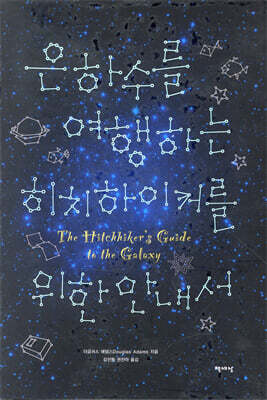이 책을 처음 알게 된 것은 영화를 통해서였다. 참 SF스러운 제목 "은하수를 여행하는 히치하이커를 위한 안내서"를 보고 나서 당연히 책에 대해서 관심을 갖게 되었다.
내가 산 건 5권 합본으로 1236쪽, 1680g짜리로 정말 괴물 같은 놈이었다. 회사에서 놓고 시간 날 때마다 조금씩 읽었는데 다 읽는데 거의 3개월이 걸렸다. 코믹 SF를 지향한다고 했는데 사실은 내용이 엄청 어렵고 이해가 잘 되지 않았다. 왜 이렇게 이해가 안될 정도로 비비 꼬았는지... 책의 중간 쯤 작가의 의도를 느끼고 부터는 마음 편하게 읽을 수 있었다.
더글라스 애덤스를 칭찬을 해주고 싶은데, 그는 과학을 그 자체를 코믹화 대상으로 봤다는 거다. 논리, 이해, 사실, 이론, 이런 딱딱한 것들을 몽땅 그의 글 재료로 써버렸다, 그냥 글 재료가 아니라 재미있는? 아마 그래서 사람들도 그렇게 열광했나 보다. 과학이라는 높이 있는 고귀하신 무엇을 땅으로 곤두박질 시켜버렸으니깐. 마치 현대 사회의 종교처럼?
예를 들어 무한 불가능 확률 추진기, 미래를 예측하는 엘리베이터, 미래의 가축, 다중 우주, 조물주가 피조물에게 남긴 최후의 메시지, 우주 끝의 레스토랑.
과학은 더 이상 멀리 있는 것이 아니다.
그의 창조적인 생각을 엿보고 싶다면 추천! 엉뚱하고 황당한걸 좋아하면 강추! 하지만 재미있는 무언가를 원하는 사람들은 책을 열어보지도 말 것!

100년 전 과학자들은 우주가 어떻게 되어가는지 문자 그대로 전연 모르고 있었다. 심지어 알버트 아인슈타인의 위대한 생각도 잘 못 되었다. 그는 우주가 멈춰있을 것이라고 가정했다. 그러나 우주는 마치 카드로 만든 집이 중력으로 붕괴되는 듯한 상태였고, 아인슈타인은 중력에 반해서 우주의 균형을 이루는, 우주 상수라 불리우는 힘이 있을 것이라는 가설을 세웠다. 1923년 에드윈 허블이 거리에 비례해 은하들이 더 많이 멀어진다는, 허불 정수를 발견했고 우주는 균등하게 팽창되고 있다는 사실이 알려지면서, 사람들은 더 이상 우주 깊숙한 곳의 미스터리 한 힘이 필요 없어졌다. 11년 전, 2명의 학생과 스페이스 텔레스코프 사이언스 연구소의 아담스가 우주상수와 비슷하게 작용하는 암흑에너지를 독립적으로 발견해서 어떻게 팽창이 시간이 지남에 따라 둔화되어 지는 것을 알맞게 설명할 수 있게 되었다.
암흑 에너지는 조금 더 자세히 밝혀지게 되었는데, Riess는 허블 우주 망원경을의 crisp view
(combined with 2003 data from NASA's Wilkinson Microwave Anisotropy Probe, WMAP)를 사용해 우주의 팽창의 비율값을 3%의 정밀도로 다시 측정했다. 이것은 20년 전 허블 상수의 2가지 사실에 대해 틀린 점을 찾기 위해 천문학자들이 측정을 수행하던 20년 전보다 크게 발전한 것이다. 이 새 값은 암흑 에너지가 아인슈타인이 생각하던 우주에 실제로 존재하며 확고하다는 것과, 우리가 생각 하는 '무엇'보다 더 활발( 마치 초기의 임플레이션 상태의 우주)하고 시간이 지나면 현저한 변화가 일어 날 것이라는 의미를 담고 있다.
May 7, 2009: Less than 100 years ago scientists didn't know if the universe was coming or going, literally. It even fooled the great mind of Albert Einstein. He assumed the universe must be static. But to keep the universe from collapsing under gravity like a house of cards, Einstein hypothesized there was a repulsive force at work, called the cosmological constant, that counterbalanced gravity's tug. Along came Edwin Hubble in 1923 who found that galaxies were receding from us at a proportional rate, called the Hubble constant, which meant the universe was uniformly expanding, so there was no need to shore it up with any mysterious force from deep space. In measuring how this expansion was expected to slow down over time, 11 years ago, two studies, one led by Adam Riess of the Space Telescope Science Institute and the Johns Hopkins University and Brian Schmidt of Mount Stromlo Observatory, and the other by Saul Perlmutter of Lawrence Berkeley National Laboratory, independently discovered dark energy, which seems to behave like Einstein's cosmological constant.
To better characterize dark energy, Riess used Hubble Space Telescope's crisp view (combined with 2003 data from NASA's Wilkinson Microwave Anisotropy Probe, WMAP) to refine the value of the universe's expansion rate to a precision of three percent. That's a big step from 20 years ago when astronomers' estimates for the Hubble constant disagreed by a factor of two. This new value implies that dark energy really is a steady push on the universe as Einstein imagined, rather than something more effervescent (like the early inflationary universe) that changes markedly over time.
원본 위치 <http://hubblesite.org/newscenter/archive/releases/2009/08/>



